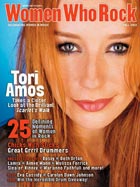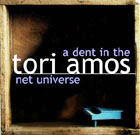|
|  |
 Tori made the cover and has a really good interview/article in the Fall 2002 issue of Women Who Rock Magazine. You can see the cover to the right. (Click it to see it larger.) I have placed half the article below. (Thanks to RoryM for sending it to me.) Please purchase the magazine to read the remainder of the interview and see the other photos, which are wonderful! Tori made the cover and has a really good interview/article in the Fall 2002 issue of Women Who Rock Magazine. You can see the cover to the right. (Click it to see it larger.) I have placed half the article below. (Thanks to RoryM for sending it to me.) Please purchase the magazine to read the remainder of the interview and see the other photos, which are wonderful!
The issue is available now on newsstands. The Dent strongly encourages you to support this excellent publication by purchasing this issue. They have done a wonderful job giving Tori the feature spot in this issue, and we should thank them by supporting and buying the magazine.
Also, if you check out the Women Who Rock web site, you will see that they have added some Tori content. They are also having a contest where the Grand Prize winner will receive a Sony Walkman, an autographed copy of Scarlet's Walk, and an autographed photo. 10 runners-up will receive a copy of the album and a Women Who Rock T-shirt.
Dent Exclusive: Tori was interviewed in New York City on August 14, 2002 for this interview. A writer on the staff of the magazine sent to the Dent two quotes from the transcript of that interview that will not appear in the magazine, but are of great interest to Toriphiles. Tori talks about how she feels about her music being released on the net too soon and also talks about her non-participation in online message boards. With the blessing of the magazine, I have placed those quotes on the Dent! Click here to read those quotes!
The Interview (The first half)
A Walk on the Wild Side
by Bob Gulla
Tori Amos' new Scarlet's Walk , a morality tale chronicling a woman's journey across a troubled American landscape, is the singer-songwriter-poet's most brilliant work since Little Earthquakes
In a hotel room full of laminated maps and semi-abstract photographs, the story of Tori's new Scarlet's Walk unfolds. The brainchlid of one of our most innocvative artists, the album is a sonic travelogue full of heartrending encounters and unlucky lovers, pognant moment and teary-eyed observers. Though Scarlet is a fictional figure, these photos and maps bring her to compelling life. As she travels from coast to coast, each song represents a specific stop along the way. Self-produced and recorded in Cornwall, England, the disc represents a stirring rebirth for Tori, and a welcome return to her vibrant musical beginnings.
You've described SW as a map of a journey. Can you explain that?
Yeah. It's something that speaks to me. When you talk about somebody's body map--an idea that I've been circling for awhile--I think that we all have an invisible map. And at a certain point in your life, you can being to look and really see which places resonate with you, pull you in. You might have only been to a place one time; you might not have even been there at all, but it's a place that gives you a physical response. And that's something that I was going for with Scarlet's Walk.
So how did the concept evolve?
I think that the songs were similar to song lines in aboriginal culture. They were my ke to take me to places. It's almost as if I were following a crossword puzzle and clues within the songs themselves. And so work started when I began seeing imagery come inl we start going back to threads, because, after all, "scarlet" is a thread. And I was following the etymology of the word. Before it was a color, it was a favric. So in old times, Elizabeth Scarlet would be a weaver, somebody who worked with cloth. And I love the idea that "Scarlet O'Hara" comes from this tradition of Irish weavers. And then There's also the "Red Rope," which symbolizes the Native American spiritual walk.
Right, all that intertwines. So then, as you were writing you got a clearer and clearer picture of the concept.
Yeah, I did. I think that there's a level of trust that you have to have with yourr song...there were 16 bars coming here and there...and I'd file [them] away, and you don't know what they mean until the concept becomes clearer.
But they meant something when you wrote these songs. You just hadn't learned it yet.
As things start to become cleaer, I can start pulling threads. I started to see my God. I didn't know I was making a political record at first. Then as time went on, I knew I was on a road trip at a certain point; I just knew. I didn't know how it was going to play itself out, though, or where the chapters would go...but then you talk about them, you surround yourself with these songs. You know they're all there.
Would you say a lot of the material cam as a reaction to the 9/11 situation? You were writing a lot at that time, right?
Yes, it's very interrelated. If I were ging to follow my quest, which was to know this being named Scarlet, I had to learn first about America. And America truly came alive for many people on that day. For Native Americans, she has always been alive, and they were caretakers of her. There was a respect that it was a spirit, the Earth Mother. So when it became clear how violated people were feeling after we'd been attacked, I started thinking also about the violation of the Native Americans. They were invaded, too, if you really want to parallel it. Back then, a way of life was taken away from an aboriginal people. Treaties were broken. Many people were running from persecution by those people supposedly seeking freedom.
So what parallels did you draw from these two events?
You have to take it historically--the transgressions as well as thw wisdom. You get the wisdom if you own up to the transgresssions. People now have to ask themselves again: How do I want to lead my life? If tomorrow doesn't come, who do I want to call today? What is the path that I want to walk? When I traveled after 9/11, there was an alertness, an awakening--there wasn't this entitlement to tomorrow, which I thought was really, really incredible for a lot of people. And there was a beautiful sort of humanness.
This ends the first half of Tori's interview. Please purchase the Fall 2002 issue of Women Who Rock magazine to read the rest!
There is a smaller sub-article about a staff member of Women Who Rock who is also an EWF, and what she did over the days when Tori was interviewed. I shold have this on the Dent at a later date!
There is still another article named "Electric Ladyland: the 25 Defining Moments of Women in Rock." Tori is #4. Here is what they say:
Tori Amos redefines thr boundaries of "personal"
The daughter of a preacher man, Tori Amos redefined sense and sensibility when she emerged as a piano-straddlin' priestess at the onset of the '90s. Her previous foray as a hard rock singer in the misguided Y Kant Tori Read was clearly over. She would not go quietly. She would sing from her heart and not be ashamed of her God-given sexuality. Her debut EP, Me and a Gun, released in October 1991, unflinchingly articulated a rape she suffered at the hands of an armed "fan" while returning home one night from a gig. Toris brutal honesty, combined with her angular piano melodies, made her debut album Little Earthquakes the hight-water mark by which all other confessional songwriters would be measured. Best Place to Hear Her: Little Earthquakes (Atlantic, 1992)
|

